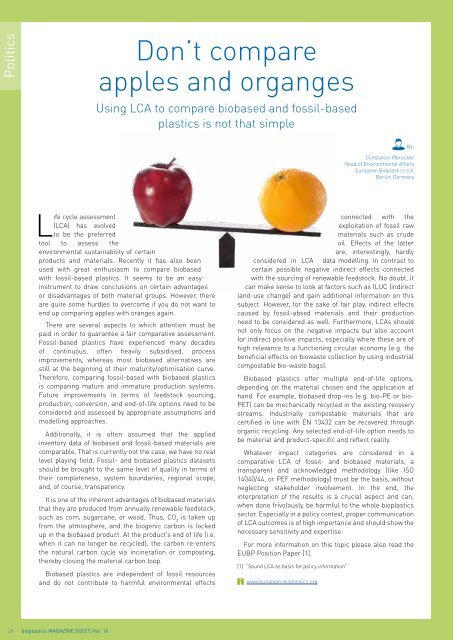issue 03/2021
Highlights: Bottles / Blow Moulding Joining Bioplastics Basics: Carbon Capture
Highlights:
Bottles / Blow Moulding
Joining Bioplastics
Basics: Carbon Capture
- No tags were found...
Create successful ePaper yourself
Turn your PDF publications into a flip-book with our unique Google optimized e-Paper software.
Politics<br />
Don’t compare<br />
apples and organges<br />
Using LCA to compare biobased and fossil-based<br />
plastics is not that simple<br />
By:<br />
Constance Ißbrücker<br />
Head of Environmental Affairs<br />
European Bioplastics e.V.<br />
Berlin, Germany<br />
Life cycle assessment<br />
(LCA) has evolved<br />
to be the preferred<br />
tool to assess the<br />
environmental sustainability of certain<br />
products and materials. Recently it has also been<br />
used with great enthusiasm to compare biobased<br />
with fossil-based plastics. It seems to be an easy<br />
instrument to draw conclusions on certain advantages<br />
or disadvantages of both material groups. However, there<br />
are quite some hurdles to overcome if you do not want to<br />
end up comparing apples with oranges again.<br />
There are several aspects to which attention must be<br />
paid in order to guarantee a fair comparative assessment.<br />
Fossil-based plastics have experienced many decades<br />
of continuous, often heavily subsidised, process<br />
improvements, whereas most biobased alternatives are<br />
still at the beginning of their maturity/optimisation curve.<br />
Therefore, comparing fossil-based with biobased plastics<br />
is comparing mature and immature production systems.<br />
Future improvements in terms of feedstock sourcing,<br />
production, conversion, and end-of-life options need to be<br />
considered and assessed by appropriate assumptions and<br />
modelling approaches.<br />
Additionally, it is often assumed that the applied<br />
inventory data of biobased and fossil-based materials are<br />
comparable. That is currently not the case, we have no real<br />
level playing field. Fossil- and biobased plastics datasets<br />
should be brought to the same level of quality in terms of<br />
their completeness, system boundaries, regional scope,<br />
and, of course, transparency.<br />
It is one of the inherent advantages of biobased materials<br />
that they are produced from annually renewable feedstock,<br />
such as corn, sugarcane, or wood. Thus, CO 2<br />
is taken up<br />
from the atmosphere, and the biogenic carbon is locked<br />
up in the biobased product. At the product’s end of life (i.e.<br />
when it can no longer be recycled), the carbon re-enters<br />
the natural carbon cycle via incineration or composting,<br />
thereby closing the material carbon loop.<br />
Biobased plastics are independent of fossil resources<br />
and do not contribute to harmful environmental effects<br />
connected with the<br />
exploitation of fossil raw<br />
materials such as crude<br />
oil. Effects of the latter<br />
are, interestingly, hardly<br />
considered in LCA data modelling. In contrast to<br />
certain possible negative indirect effects connected<br />
with the sourcing of renewable feedstock. No doubt, it<br />
can make sense to look at factors such as ILUC (indirect<br />
land-use change) and gain additional information on this<br />
subject. However, for the sake of fair play, indirect effects<br />
caused by fossil-absed materials and their production<br />
need to be considered as well. Furthermore, LCAs should<br />
not only focus on the negative impacts but also account<br />
for indirect positive impacts, especially where these are of<br />
high relevance to a functioning circular economy (e.g. the<br />
beneficial effects on biowaste collection by using industrial<br />
compostable bio-waste bags).<br />
Biobased plastics offer multiple end-of-life options,<br />
depending on the material chosen and the application at<br />
hand. For example, biobased drop-ins (e.g. bio-PE or bio-<br />
PET) can be mechanically recycled in the existing recovery<br />
streams. Industrially compostable materials that are<br />
certified in line with EN 13432 can be recovered through<br />
organic recycling. Any selected end-of-life option needs to<br />
be material and product-specific and reflect reality.<br />
Whatever impact categories are considered in a<br />
comparative LCA of fossil- and biobased materials, a<br />
transparent and acknowledged methodology (like ISO<br />
14040/44, or PEF methodology) must be the basis, without<br />
neglecting stakeholder involvement. In the end, the<br />
interpretation of the results is a crucial aspect and can,<br />
when done frivolously, be harmful to the whole bioplastics<br />
sector. Especially in a policy context, proper communication<br />
of LCA outcomes is of high importance and should show the<br />
necessary sensitivity and expertise.<br />
For more information on this topic please also read the<br />
EUBP Position Paper [1].<br />
[1] “Sound LCA as basis for policy information”<br />
www.european-bioplastics.org<br />
26 bioplastics MAGAZINE [<strong>03</strong>/21] Vol. 16


















